The top-performing backpacks with hydration bladders for cycling
The best hydration packs are extremely useful. Even with the advent of bib shorts with cargo pockets, nothing compares to a pack with a hydration bladder when it comes to water and gear-hauling capacity.
The best packs can help you be prepared out on the trails and organise your riding essentials. Plus, carrying up to three litres of water (the equivalent of four large bottles) comfortably allows for big, all-day rides.
Hydration packs, like everything else in the bike world, have evolved brilliantly. There’s a huge range of shapes, sizes and features.
Our list of the best hydration packs will help keep you hydrated, comfortable and ready to take on the trails. Keep reading until the end for our buyer’s guide on what to consider when buying a hydration pack.
Best hydration packs in 2024
CamelBak Chase Bike Vest
- Price: £95
- Reservoir capacity: 1.5l
- Storage capacity: 4l
- Pros: Well thought-out storage; excellent bladder; super-comfortable and stable on the bike
- Cons: None
Broad shoulder straps make the Chase Vest very comfortable, while the quick-reach pockets are ideal for storing phones, tools or snacks.
The internal storage features two zipped inner compartments large enough to stash most kit, while the elasticated overflow pocket is big enough to carry a waterproof jacket in.
The Chase Vest is incredibly stable, even when jostled about on the gnarliest terrain.
CamelBak Chase 8L Vest hydration pack with 2L Fusion bladder

- Price: £140
- Reservoir capacity: 2l
- Storage capacity: 8l
- Pros: Incredibly comfortable; easy-access storage; stable when riding; excellent bladder
- Cons: Fabric bladder hanger snapped
With six litres of well-considered storage space, this pack can swallow all the kit you need for long rides.
The bag is made from a tough Dimension-Polyant LS07 sailcloth fabric, which offers some weatherproofing, although not enough to keep your gear dry in a downpour.
The straps are wide, distributing weight well, while the pockets keep items such as phones close to hand.
CamelBak H.A.W.G. Pro 20

- Price: £170 / $170 / €175
- Reservoir capacity: 3l
- Storage capacity: 20l
- Pros: Impressive airflow; good organisation options; bladder included
- Cons: No rain cover; pocket entrance could be bigger
The H.A.W.G. Pro 20 is a great choice for those wanting large, comfortable carrying capacity for big days in the saddle.
We found the organisation of the bag handy, with the removable tool wrap helping to keep potentially damaging items out of the way of the rest of the bag’s contents.
With exceptional airflow and adjustability, the H.A.W.G. Pro 20 was comfortable to wear for long durations and remained cool on warmer days.
However, we found the entrance to some of the pockets a little restrictive.
CamelBak Skyline LR 10
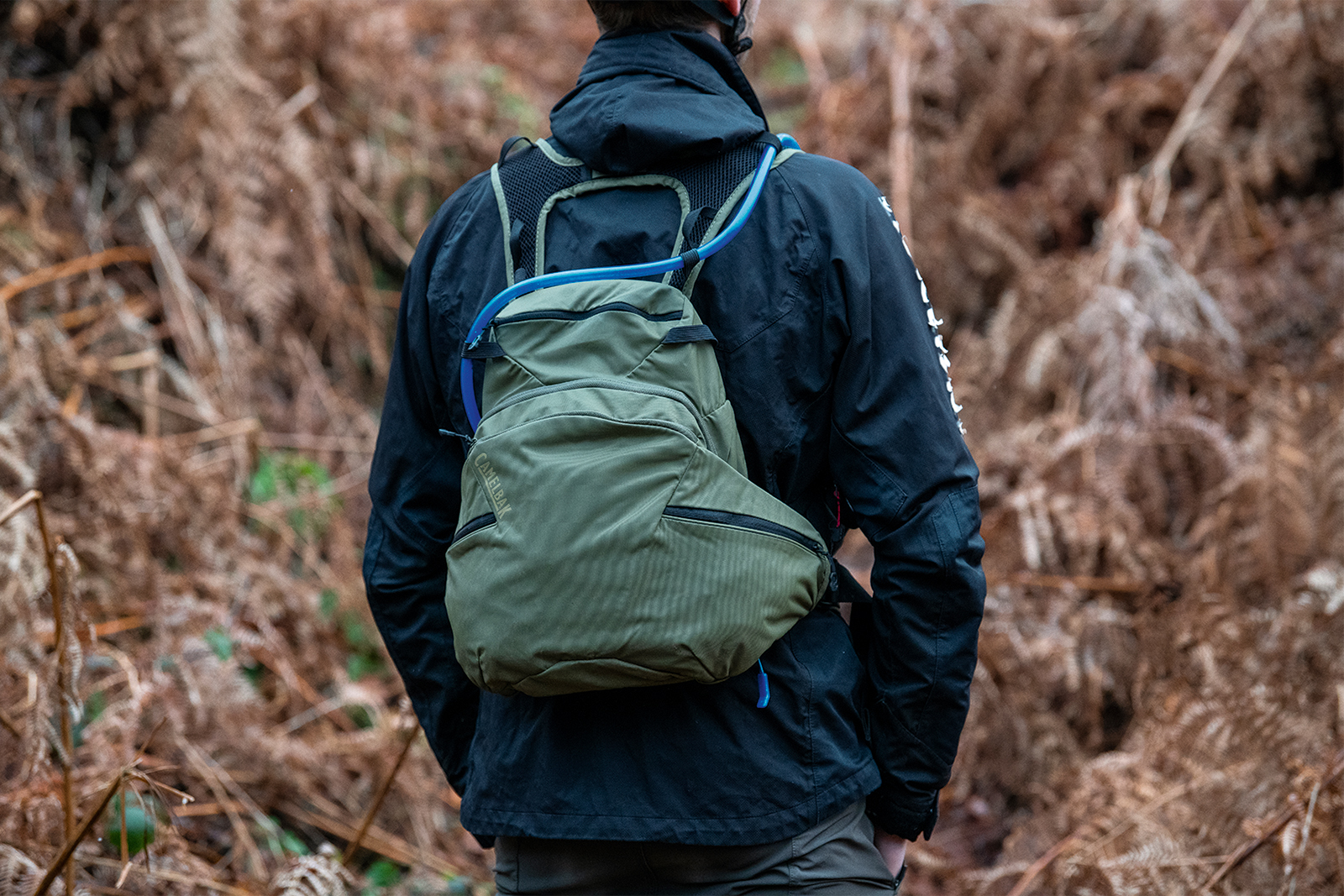
- Price: £115 / $135
- Reservoir capacity: 3l
- Storage capacity: 10l
- Pros: Drinking hose can be run on both sides; comfortable for long days; well-considered pockets
- Cons: Not the most attractive; long items don’t fit the best
The CamelBak Skyline LR 10 looks like a crossover between a bum bag and a backpack. This might seem strange, but the positioning on your back paired with a wide waist belt makes this an absolutely steadfast pack.
Water is carried in CamelBak’s 3l CRUX lumbar reservoir, which keeps the centre of gravity of the pack low. A quick-release clip decouples the bladder from the drinking tube and a wide opening makes for easy filling.
When the reservoir is full, there’s seven litres of storage room for tools and gear. If you’re looking to carry lots of kit, this bag isn’t the answer, but otherwise, it does a superb job.
CamelBak Women’s Chase Vest
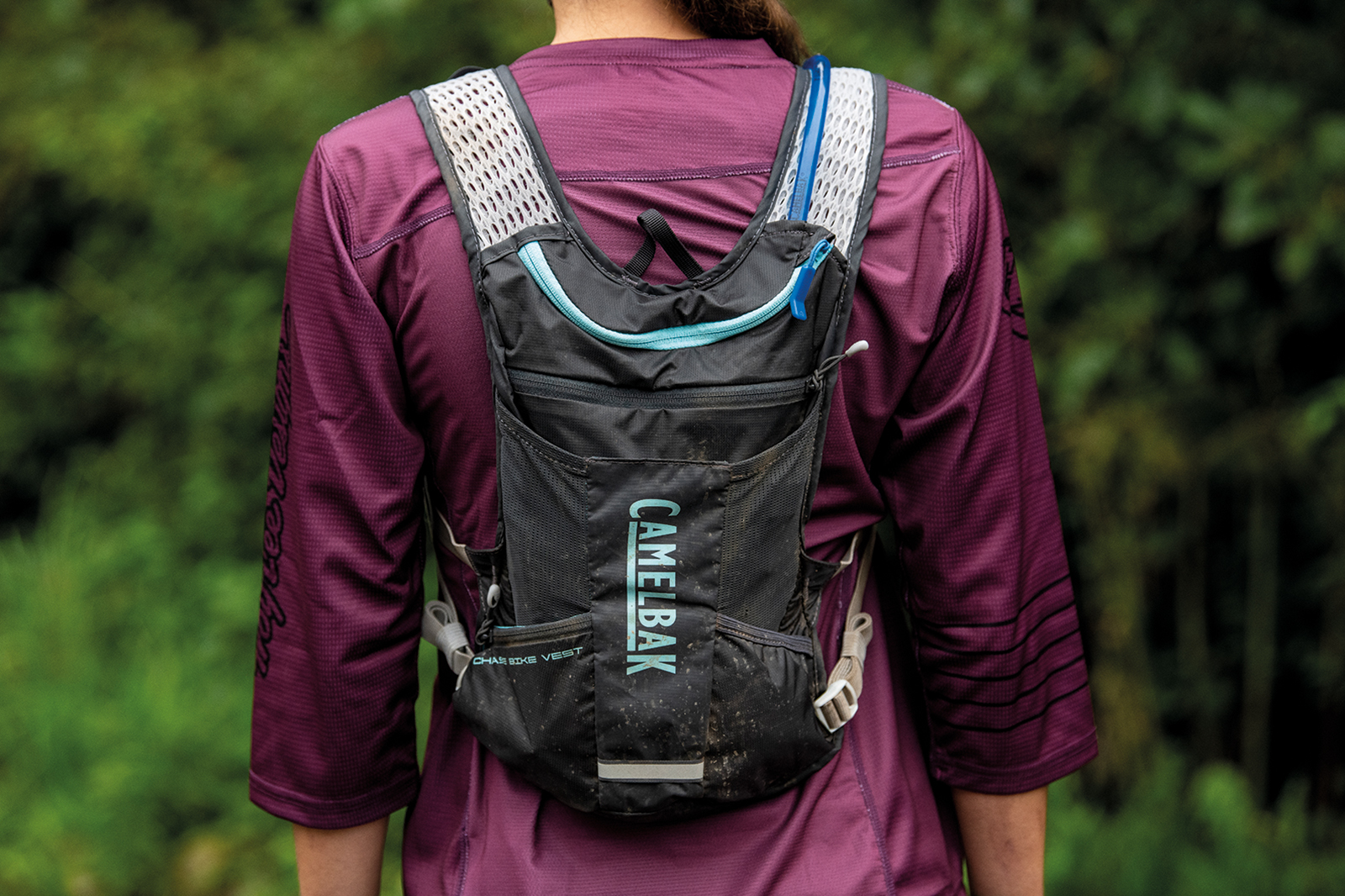
- Price: £90 / $100 / €103 / AU$150
- Reservoir capacity: 1.5l
- Storage capacity: 2.5l
- Pros: Smartly arranged pockets; female-specific cut helps; robust
- Cons: Hose could be a little shorter
Designed as a vest, even though it appears more like a pack, the Chase has a women’s-specific fit that does a great job and keeps the pack in place.
Eight smartly arranged pockets enable you to quickly access snacks and your phone, for instance, without having to take the vest off.
There is room for 1.5l of water and the Chase has a total capacity of 2.5l. This means there isn’t a great deal of room if the bladder is full, but there is still enough for a light jacket, pump and other essentials.
This pack would be ideal for enduros and shorter rides.
EVOC Stage 6

- Price: £120
- Reservoir capacity: Not included
- Storage capacity: 6l
- Pros: Wide and stable design; easy-access compartments; comfortable for long days
- Cons: No bladder included; hip pockets would be a big improvement
EVOC’s Stage 6 offers steadfast security on technical trails, with large foam-padded straps making it comfy on long days out.
The bag maximises its capacity, with a wide opening to the main pocket, meaning you can fit all the essential trail-side tools inside.
There are plenty of mesh features on the rear of the bag to keep air flowing to your back, avoiding sweat build-up.
EVOC Stage 12l

- Price: £114.99 / $140 / €129
- Reservoir capacity: 3l
- Storage capacity: 12l
- Pros: Comfortable and easily adjusted; plenty of pockets; decent helmet-carrying capability
- Cons: No bladder included
The EVOC Stage 12l bag is arguably a rucksack before it is a hydration pack, but it does have a sleeve that will happily fit a 3l bladder and shoulder straps that have hose guides built-in.
The Stage is comfortable to wear thanks to large, rigid foam sections and mesh panelling that sits against the back. The shoulder straps are comfortable over the shoulders and the pack is stable even over rough terrain.
Inside, there’s 12 litres of storage with a multitude of pockets and dividers. A dedicated tool pocket is easy to open and access quickly.
The bag has an in-built rain cover, but water beads off the material too.
The one downside is the EVOC Stage doesn’t include a bladder and, arguably for the price, it should.
Source Summit 15L
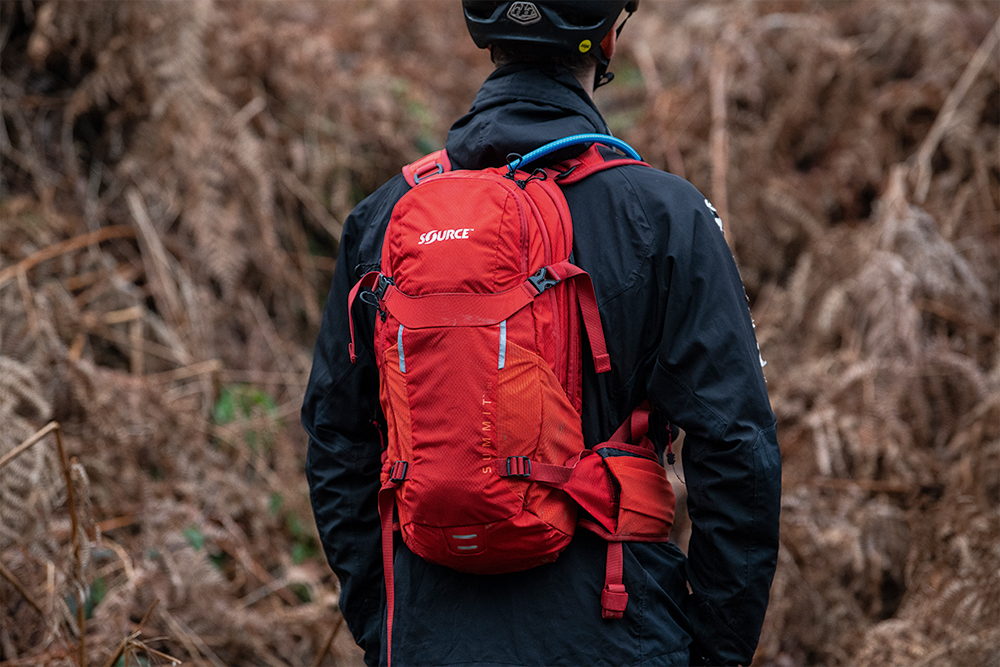
- Price: £110 / €140
- Reservoir capacity: 3l
- Storage capacity: 15l
- Pros: Well-organised storage; compression straps add stability; lots of extras
- Cons: Quite hefty and not that breathable
With 15l of capacity, the Summit is the biggest hydration pack from Source. This might feel excessive for shorter rides, but come long days in the saddle this extra space will be appreciated – especially because inside there are mesh dividers, making organisation easy.
Source includes its 3l Widepac hydration bladder, which is held in its own insulated compartment, keeping water at an even temperature. The hose is insulated too and unclips from the reservoir for easy filling.
The large capacity of the pack means it covers a lot of the back, which helps distribute weight, but it means the Summit can be warm to wear.
Thule Rail 8L

- Price: £120
- Reservoir capacity: 2l
- Storage capacity: 8l (tested), 12l and 18l
- Pros: Wide opening and easy-to-access pockets; good tool organiser; magnetic hose retention
- Cons: Badder is hard to remove
With great technical details, the Rail hydration pack offers great usability with handy access pockets on the hips.
The large main pocket features a generous organiser, with compartments for various tools and a pump.
The Rail is only let down by the lack of arm choice for the tube and a frustratingly tight loop for supporting the reservoir in the bag.
Vaude Bike Alpin 30 + 5

- Price: £145 / €170
- Reservoir capacity: 5l
- Storage capacity: 30l
- Pros: Impressive versatility; brilliant airflow; plenty of adjustment
- Cons: Initial adjustment can be time-consuming; no whistle; bladder not included
The Bike Alpin 30 + 5 make for an excellent day pack, while offering the storage capacity for longer expeditions.
We were impressed by the pack’s versatility and features, with a handy phone pocket that’s easy to access while riding and plenty of storage compartments.
The lack of bladder at this price point is slightly disappointing, but the bag’s comfort and quality make up for this.
Decathlon Rockrider Explore 7L/2L

- Price: £35
- Reservoir capacity: 2l
- Storage capacity: 7l
- Pros: Amazing value; handy mesh pockets; wide main pocket
- Cons: Can get sweaty; no tool compartment
The Rockrider Explore hydration pack crams high-end features into a budget bag, while also including a reservoir.
Zipped hip pockets allow for easy access to essentials, and are big enough to fit a phone inside.
The straps and rear feature mesh to allow airflow, and while not as complex as more expensive bags, they proved just as effective.
A locking bite valve is a nice addition at this price point, keeping car seats from being soaked on the way to a ride.
Decathlon Rockrider 12L
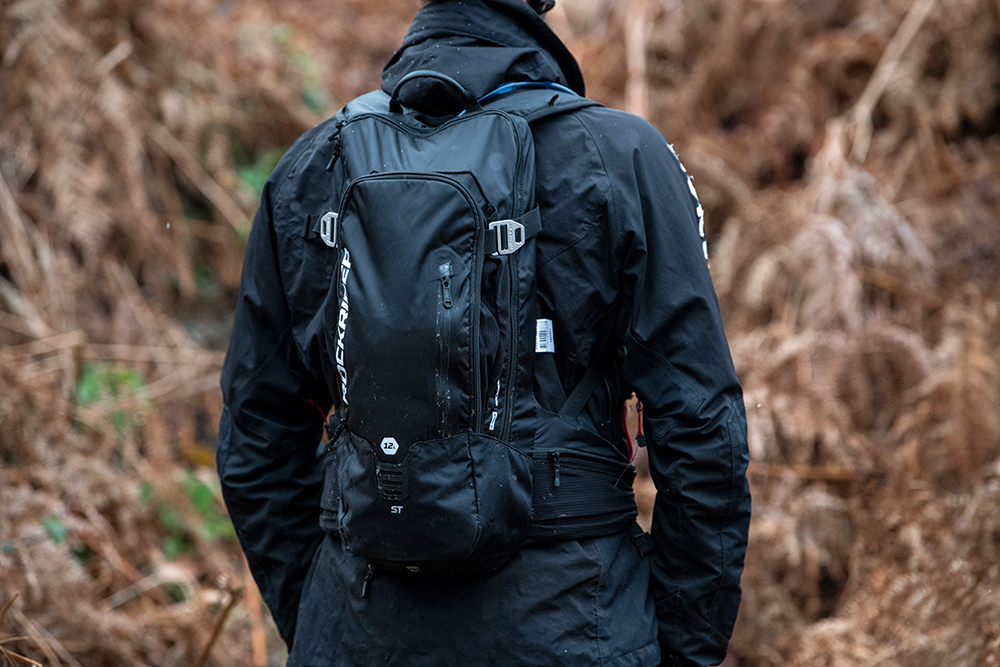
- Price: £40
- Reservoir capacity: 2l
- Storage capacity: 12l
- Pros: Comfortable and snug fit; good stability; plenty of airflow
- Cons: Hose is easy to kink
The Decathlon Rockrider 12L is a great entry-level hydration pack and competes well with the other packs we tested. The inclusion of a bladder is also a plus over some of the pricier packs in this list.
The 12l of storage is well organised with internal dividers and there is a front pocket, but strangely it isn’t sewn up the whole way at the bottom.
The bladder doesn’t match the quality of a brand such as CamelBak and the hose is thin, but it is hard to fault for the money.
The pack is well ventilated and has a bright cover built-in, which is ideal for commuting or the colder, dimmer months of the year.
Osprey Escapist 30

- Price: £150 / $180 / €165
- Reservoir capacity: 3l
- Storage capacity: 30l
- Pros: Good adjustability; plenty of internal storage; easy access to bladder
- Cons: Not the most stable on descents; helmet carry not compatible with all lids
The Escapist 30 is a good choice for those long days in the saddle, with plenty of storage space and good versatility.
Well-considered external pockets and internal compartments do a good job of keeping things organised, although we would have liked more zipped pockets.
The pack offers good airflow and adjustability, helping to keep it comfortable for long distances, but it moved around quite a bit on bumpy descents.
Osprey Raptor 10

- Price: £110 / $140
- Reservoir capacity: 2.5l
- Storage capacity: 10l
- Pros: Impressive comfort; good weight distribution; built-in tool roll
- Cons: Drinking hose routes across the chest; no way to carry a full-face
The Raptor is pitched as Osprey’s ‘premium’ hydration pack. It is designed to carry essentials rather than lots of kit and has excellent construction. It also includes a hydration reservoir, while many we tested did not.
The Raptor’s main compartment unzips fully, making for easy access. Long organiser pouches are suitable for essentials, particularly a pump.
On the outside, there are two small pockets for eyewear and valuables, plus an expandable pouch and Osprey’s LidLock device for carrying a helmet.
The pack fits well and is comfortable. The Airspace back panel has two foam pads for ventilation and the waist strap keeps the pack secure.
The 2.5l reservoir is stored in a separate compartment that zips open, making it easy to remove and fill.
Why you can trust BikeRadar
BikeRadar has been an authority on bikes and cycling tech since its inception in 2007, delivering the world’s best riding advice.
We have experts testing all types of bikes, parts, clothing and accessories, from road, mountain and gravel bikes to commuting, bikepacking and electric bikes.
Our reviews are always editorially independent – with no exceptions. Our reviewers comprehensively test all products in the real world, always reflecting on performance, value and the wider market when delivering their verdicts and review ratings.
We have more than 15,000 product reviews available at your fingertips, as well as expert buying, maintenance, training, skills, health and fitness advice.
Our annual Bike of the Year test is an industry benchmark and the BikeRadar team consists of some of the most experienced riders and testers in the business.
Buyer’s guide to hydration packs
What is a hydration pack?

Hydration packs are either backpacks or hip packs that contain a reservoir for water, with a length of tube and a bite valve to get the water to your mouth. They come in a variety of sizes and styles to suit any type of riding.
Hydration packs have benefits over water bottles because they enable riders to carry more water – typically 2 to 3 litres rather than the 1.5 litres of two large bottles.
A pack enables you to bring along more food, tools, clothing and other riding essentials. In some instances, they can provide back and spine protection.

You might think of CamelBak when you hear the words ‘hydration pack’. That’s common, and CamelBak created the original hydration pack back in 1989.
To say the first iteration was simple is an understatement. CamelBak founder Michael Eidson slid an IV bag into a tube sock when he was competing in a bike race in Texas called the Hotter ‘n Hell 100. The packs have come a long way since then.
Over the years, the number of manufacturers making hydration packs has exploded. Hydration packs tailored to the demands of hiking, running, snow sports and even the military now exist alongside cycling-specific bags.
Within cycling, there are now low-profile packs for road use, hip packs for shorter rides, all-day packs with enough room for food, clothes and gear and even pint-size packs for kids.
What to consider when buying a hydration pack
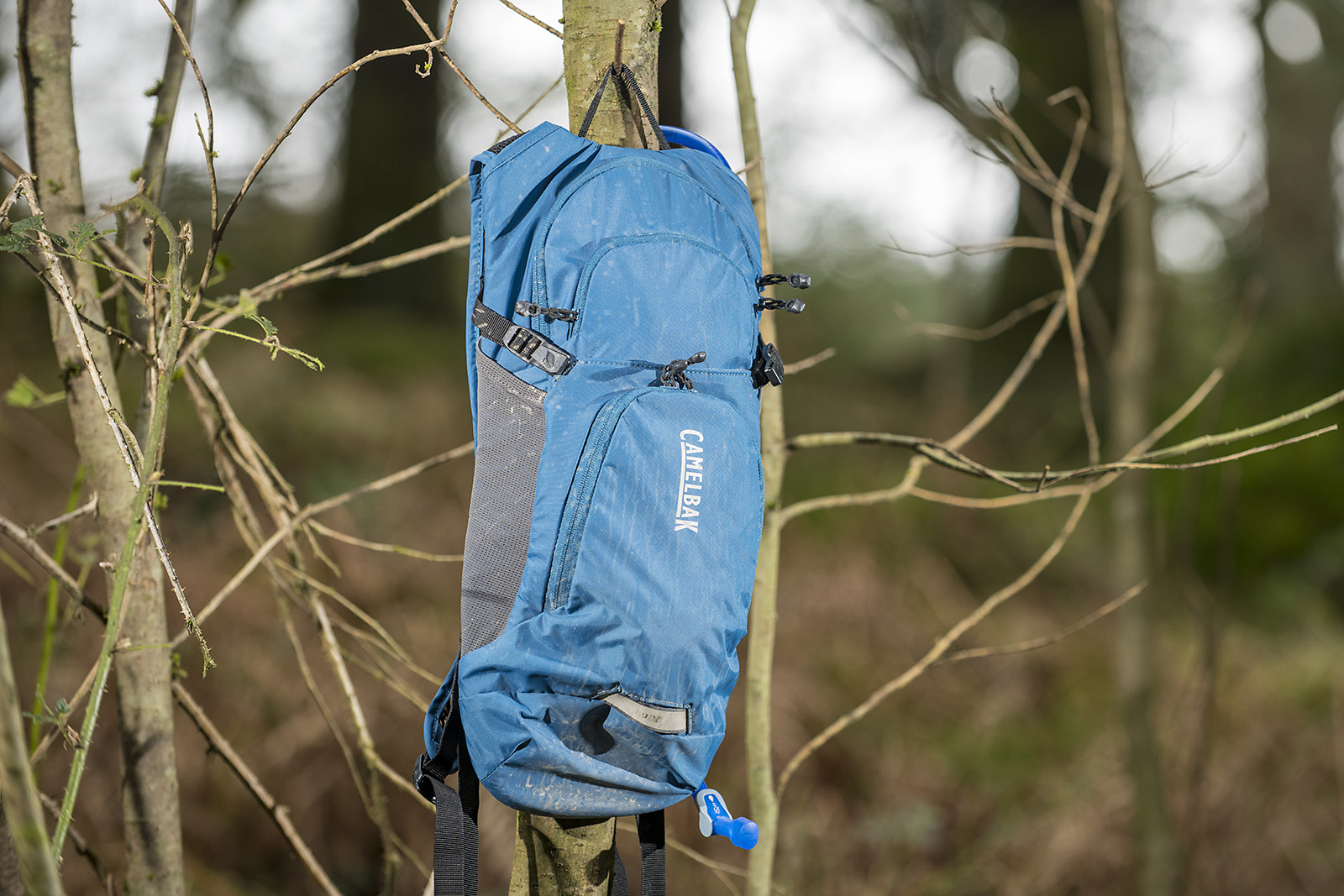
Water capacity
Hydration pack fluid capacity varies from about 1 to 3 litres. How much do you need? That depends on you. It also depends on the temperature, how long you plan to be out and the availability of refills.
How much should you drink? Drinking water is essential for maintaining performance and a very general baseline recommendation is roughly half a litre for every hour. This, of course, is highly dependent on heat, humidity and your personal chemistry.
Capacity for gear
One of the best reasons to use a hydration pack as opposed to bottles is the ability to haul gear. Mountain bikes have become more reliable, but flat tyres, bent wheels and broken chains can still happen. When they do, in the middle of nowhere, it’s essential to have the parts and ability to fix them.
Carrying food and extra clothes is also relatively easy with a pack. Most hydration packs also have fleece-lined pockets for sunglasses, goggles and cameras.
Straps and harnesses

Almost all rucksack-style hydration packs are built with the features you can expect from the best cycling backpacks. These include padded, ventilated shoulder straps, hip belts for stability, and sternum straps to pull the shoulder straps together.
On the back panel, where the pack sits on your back, look out for channels to get a bit of airflow in there and help you stay cool. Some packs even have a suspended mesh back.
Hip packs
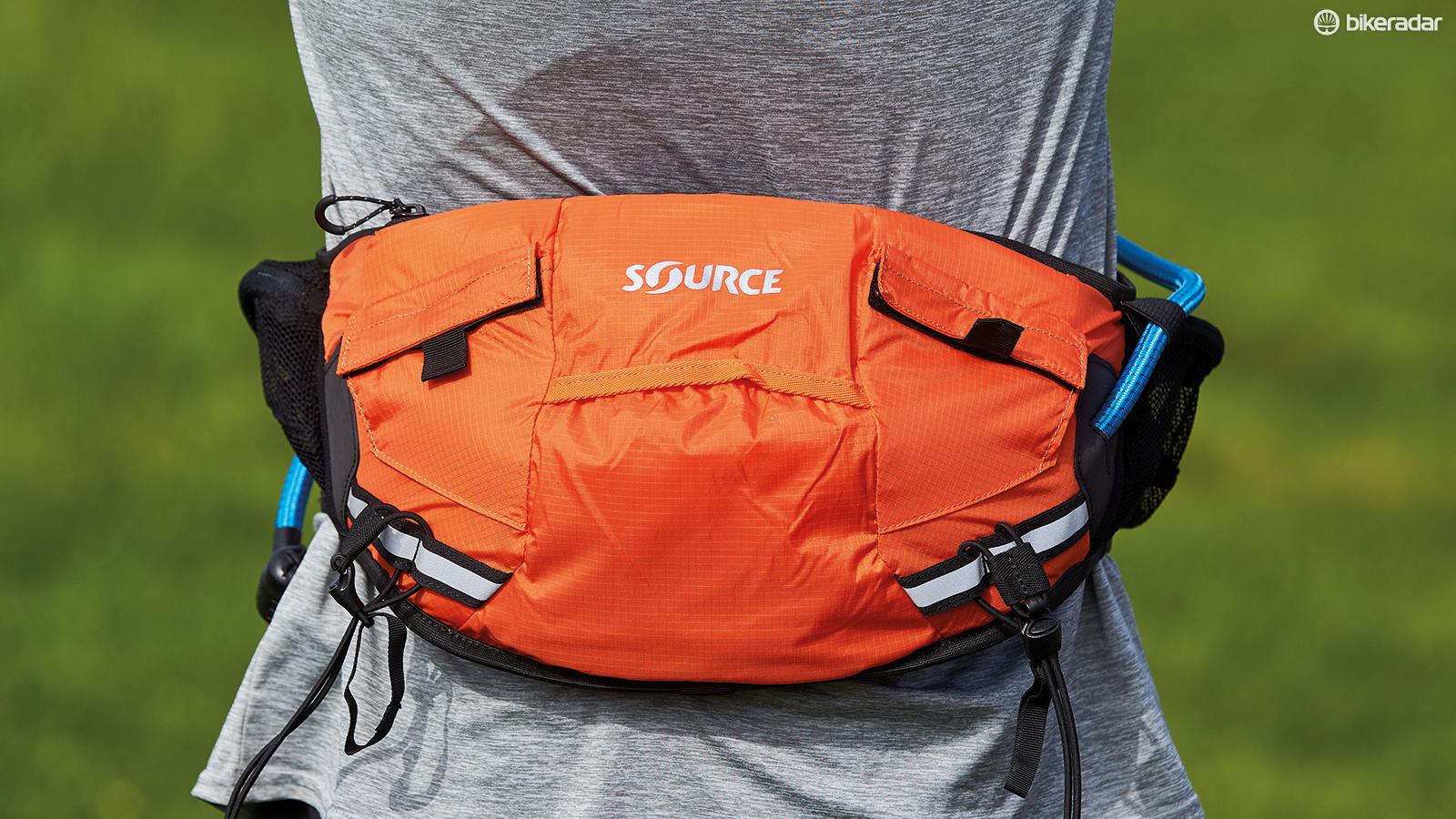
The best hip packs help you stay hydrated and carry tools on a ride.
Compared to rucksack-style hydration packs, they tend to offer less storage capacity and have smaller bladder sizes. This makes them ideal for when you don’t need to carry so much kit and don’t need to drink as much water. They are also good if you simply prefer to not have a rucksack against your back whilst riding, which can be a nuisance, particularly in hot weather.
Hip packs tend to have capacity for about 1.5 litres of water, so they still provide enough hydration for a decent ride. Storage capacity is lower than rucksacks and is often around 2 litres, but some hip packs go up to 5 litres.
Bite valve and hose
The bite valve is crucial because it’s where the water meets your mouth.
Bite valves are typically comprised of soft rubber. Some require a simple squeeze to unleash the flow of water, others involve pressing a button with your tongue. Almost all bite valves have a lock or shut-off feature, which is invaluable when tossing a hydration pack in a car or another larger gear bag.
The hose on most packs can be trimmed to length. On the pack itself, there will be hose guides and mounting clips to keep the hose from swinging about when riding.
Optional hose accessories include sleeves to keep the water warm or cold (depending on the season) and even semi-rigid setups for angling the bite valve closer to your mouth.
Built-in body armour
A few pack manufacturers incorporate body armour-style padding and impact-absorbing plates into their packs to enhance protection. Reservoirs are built tough so they’re able to withstand the force of a hit.
Access and filling the reservoir
Hydration packs vary in how you get at the bladder itself. Some reservoirs reside inside the main pack, which saves weight, while others have their own dedicated compartment for protection from pokey tyre pumps, tube valves and multi-tools.
Most reservoirs feature a detachable hose to make filling easier. To fill bladders with a permanent hose requires either slipping the hose out of the bag or carrying the whole bag over to the tap.
Looking after your hydration pack
Cleanliness is essential to hydration pack bladders. Ideally, they should be emptied immediately after use and hung out to dry. Several companies make drying inserts to keep the internal surfaces apart, and many riders modify a coat hanger for the job.
Another solution is keeping it in the fridge, where the cold keeps nasty stuff from growing.
It’s recommended to only put water in the reservoir, simply because cleaning out sports drinks thoroughly is almost impossible. This inevitably leads to bacteria growth and then buying a new hose, bite valve or entire reservoir.
Other features
Hydration pack makers have really nailed the organisation part of the bags.
All sorts of features are found in packs: special pockets for pumps and tools; hooks for keys; whistles; elastic cords for lashing on a jacket; helmet carry straps for when you’re off the bike; expandable compartments; headphone ports; and many others.
It’s worth reading the detailed specs to find out what’s on offer and thinking about what extra benefits would be useful for your riding style.
Jargon
Harness: The arrangement of shoulder straps, sternum (chest) strap and waist belt that secures the pack to your back. Some designs do away with the waist belt and rely on an extra sternum strap to pull the shoulder straps in tight.
Compression straps: On bigger packs especially, additional external straps are useful for cinching down your cargo to stop it shifting around when the bag isn’t stuffed to full capacity.
Certified back protector: Level 1 or level 2 certification indicates the amount of impact energy transmitted through/absorbed by a CE-approved back protector. Level 2 designs offer more protection but are likely to be bulkier.
Bite valve: The rubber mouthpiece at the drinking end of the hose. This is usually replaceable and most have a twist-lock or lever closure to prevent leakage. Some come with a protective cap too, which is a plus for muddy rides.
HydraPak: A third-party supplier of hydration systems. A lot of brands use HydraPak reservoirs, hoses and bite valves in their packs, and we’ve rarely had a problem with them. Spares of nearly every component are available too.